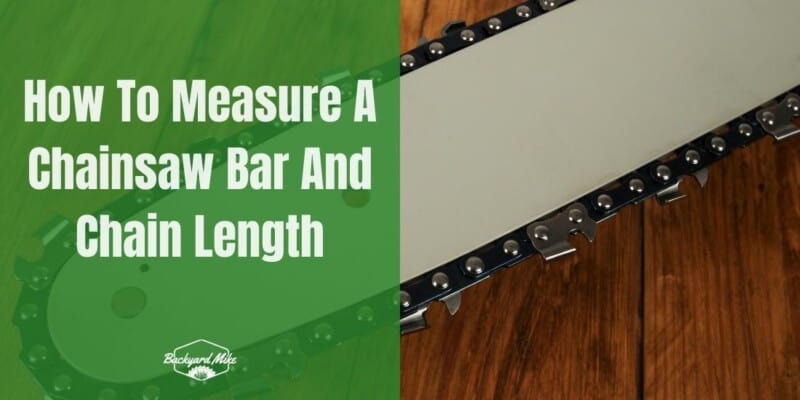You’re looking to replace your chainsaw bar or chainsaw chain, but you don’t know what size you’ll need.
Simply guessing isn’t the best way. Instead, let me show you how to get the most accurate measurement on your chainsaw bar and chain. My guide here will be useful if you’ve lost your manual or just don’t know where to start with your measurements.
At the end of the guide, you’ll realize how easy it is to measure your chainsaw bar, so there’s no need for any vague and inaccurate estimations!
How to Measure A Chainsaw Bar
As you’re shopping for your chainsaw bar (also known as chainsaw blade or chainsaw guide), you’ll need to have two measurements in mind. They are the effective length and the true length.
Step 1: Safety First
Before you even start, the first thing to do is to shut your chainsaw. Remember to unplug its spark plug too (it’s on the rear of your chainsaw, hidden under the carburetor box).
Yes, you will have to remove the bolt that holds down the carburetor box to get to the spark plug. Turning your power tool off completely is essential, so it doesn’t turn on when you’re doing your measurement.
Step 2: Getting The Effective Cutting Length
This is the simplest type of measurement because the effective cutting length is really just the length of the bar.
This is the length from the tip of the blade to where the bar is actually attached to the chainsaw. It’s fairly easy to measure: all you need to do is place your tape measure at the base of the blade, going to the tip of the blade. You’ll measure just until the bar disappears into the chainsaw body in order to find the cutting length.
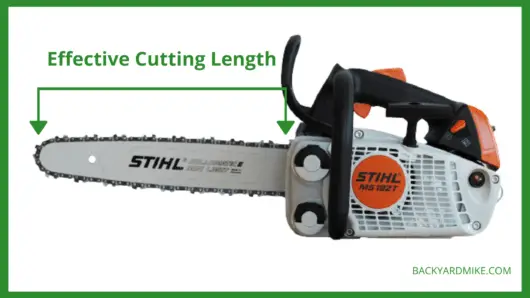
Remember to keep the chainsaw on a flat and steady surface in order to get the most accurate read.
You might not have an exact number by doing this, so no matter what your measurement is, just round up to the nearest even number in inches.
Just as an example then, if you get 18 and ½ inches for your length, the best thing to do is round up to 20 inches, since 20 would be the nearest even number. Avoid rounding up to 19 since it’s not an even number. This is because chainsaw measurements are not taken in odd numbers, so you would never say you have a cutting length of 19 inches.
Likewise, for 17 and ¾ inches, you would round up to 18.
Step 3: Getting The True Length
Then we have the true length. This is the second way to measure your chainsaw bar. Put simply, it is the full bar length when it’s not installed in the engine of the chainsaw.
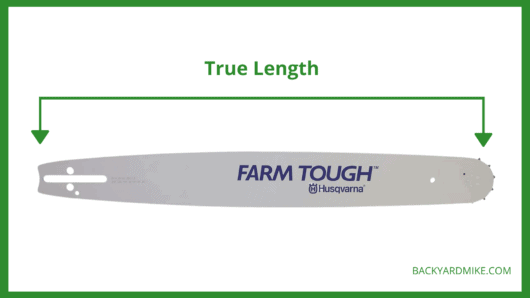
When it comes to the truth length measurement, you’ll have to take the bar out of the body casing. When measuring the true total bar length, unscrew the bolts with a wrench or socket and carefully remove the bar from the casing. Look on the right side of the base—the bolts will be just near the base of the bar. This is something you’ll need to do anyway if you want to replace the bar with a new one.
Very carefully, as you are still dealing with a blade, place the bar flat on either the ground or on whatever workspace you have. From this point, you’ll only need to measure the distance from end to end, and this time, you don’t need to round up the numbers.
Step 4: Shopping for a New Chainsaw Bar
As you’re looking for a new bar then, you’ll take both of these measurements to pick out a blade that will fit. You should be able to find a perfect replacement. Click here to check our review of the best chainsaw bars on the market.
Why Can’t I Use Any Bar Size?
You might know this already, but the bar is not a one-size-fits-all kind of thing on your chainsaw. Not all chainsaws are compatible with all bar lengths, at least partially due to the fact that longer bars will need higher engine power.
You can’t simply put a large bar on your chainsaw. Neither can you just take a chainsaw with a weaker engine and try to install a longer bar—it just won’t work right.
If you have an electric chainsaw, you’ll find that it won’t work with anything longer than an 18-inch blade just because the motor will not be able to work with the longer bar and chain. Chainsaws with longer bars will use a more powerful engine—usually gas chainsaws.
If you have the manual for your chainsaw, it should tell you the bar length options you have. Definitely don’t use a chainsaw bar that is longer than what the manufacturer recommends, as this can have a negative impact on the engine power and speed.
Understand that with a longer chainsaw bar, the engine will use more power for the chain speed which will speed up the wear and tear on the engine.
How to Measure a Chainsaw Chain?
If you’re measuring and replacing the chainsaw bar, you might also wonder how to measure a chainsaw chain length.
To give you the right expectations, know that measuring a chainsaw chain length is somewhat more challenging than measuring a chainsaw bar. Instead of just two measurements, you will need three chain measurements.
First off, be very careful when you’re replacing and unscrewing the bar because you’ll need to unscrew and detach the chain as well.
Measuring the Chainsaw Chain
Here are the three measurements you need to know:
- To start, count the number of drive links. That is the number of drive links along your chain. You’ll then need to measure the pitch (also known as the chain size). In other words, measure the distance between every link.
- Measure the length between any three consecutive rivets, which are what hold all the drive links together. From here, divide by 2 to get the pitch. Generally, you’ll get a number of ¼’’, .325’’, ⅜’’, or .404’’.
- Finally, proceed to measure the gauge. The gauge is the width of the groove on the chain that will fit into the bar (and this is why you’ll want to make sure that you get the right-sized bar too, when you’re replacing it). To get this measurement, just use the tape measure to find it on the chain.
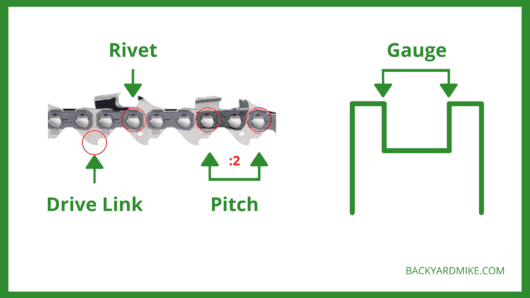
Don’t want to measure the gauge with a tape measure? Here’s a nifty trick for you:
All you need is a quarter, a penny, and a dime. First, make sure the groove is completely clean and free of debris, then grab your quarter. See which coin fits best in the groove (penny, dime, or quarter). Once you’ve figured it out, here are the measurements for your gauge:
- Quarter fits best: 0.063
- Penny fits best: 0.058
- Dime fits best: 0.050
Check For Measurements On the Blade
Just in case you didn’t know, you can actually find the measurements of the chain on the blade itself.
The measurements you need are often stamped onto the blade, right at the end, where it’s usually be hidden by the bolted cover. Once you take the blade off, you might be able to see these numbers.
You’ll only need to take the numbers to a hardware store to get the right-sized chain.
However, if the measurements have worn off and you can’t quite see them properly, it’s still good to know how to do the measurement yourself.
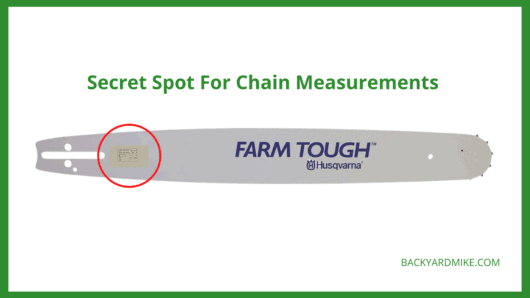
Don’t Guess
You might think that you can estimate the length of your bar and that it should be good enough for you to pick out a new one and get it installed. Especially considering the few measurements you need to do though, it’s best if you get those exact measurements instead of guessing.
If you guess, you might end up installing a bar or a chain that isn’t meant to be used on your chainsaw. This might end up damaging your tool, and in the worst case, it might lead to a situation where you accidentally misuse the tool while you’re operating it.
Considering how dangerous a chainsaw can be, you’ll want to avoid this at all costs.
Conclusion
As you can see, measuring your chainsaw bar isn’t all that difficult. Instead of guessing, you can measure a chainsaw bar easily to find the right replacement.
Measuring the true length will take a bit more work than measuring just the cutting length since you’ll have to take the bar out of the casing, but both measurements shouldn’t take too long. So long as you can work a tape measure and do basic math, you should be able to accurately measure your chainsaw bar.
Knowing the length of your chainsaw bar will ensure that your chainsaw will continue to work as good as it should over the long run, and that you’re able to get the right chain to accompany it too. Just make sure that you make all of your replacements safely and with the proper safety equipment.

